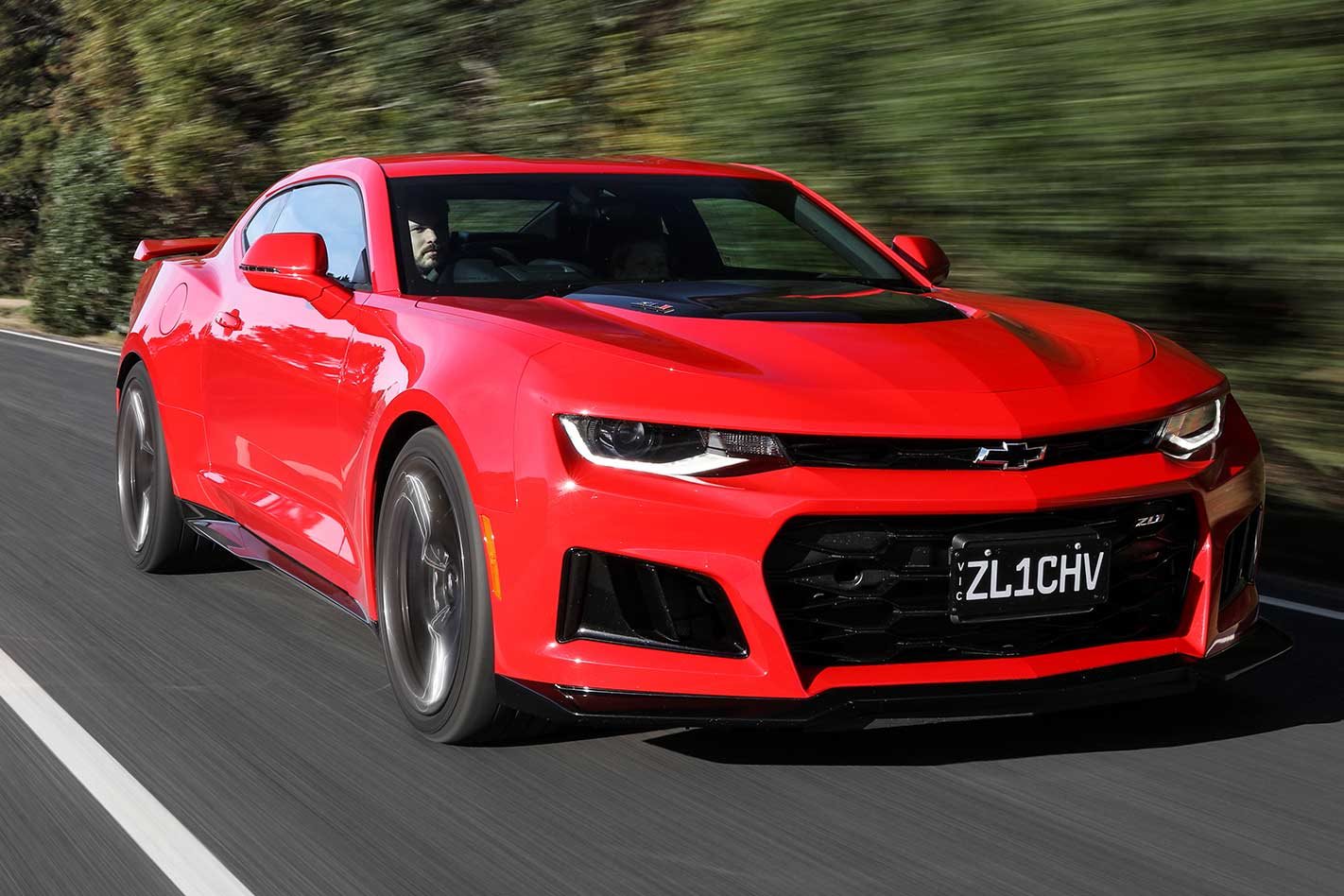- Introduction
- Update 1: Fear Factor
- Update 2: New Rivalry
- Update 3: Power Hungry
- Update 4: Brothers in Arms
- Update 5: Farewell
Introduction
When the GTS-R W1 sold out and signalled the Commodore’s time at HSV was up, it revealed something remarkable about Aussie buying habits. Specifically, we’d hand over significant sums of cash ($169K) when an HSV is cranking out 474kW and 815Nm.
Of course, earth-turning power wasn’t everything to it – those last-of-the-line serial numbers were pretty important too. But a GM-bred LS9 engine bolted into a rear-driver guaranteed a lot of appeal.

So it seemed good sense that when HSV secured the rights to re-engineer Chevrolet Camaros from left- to right-hand drive, it tried its best to nab something with close to the same grunt. Something like our newest long-termer, the Camaro ZL1.
What’s a ZL1? Simply put, it’s the most powerful and fastest Camaro sold in the United States. It relies on an LT4 V8 for firepower, a 6.2-litre small-block that spins a 1.7-litre supercharger to produce 477kW and 881Nm.
Matched to GM’s 10-speed automatic transmission that, ironically, was co-developed with Ford, grunt is channelled to the rear wheels. There’s an electronic differential up back as well, along with fat 305mm tyres.
Chevrolet claims accelerating from zero to 97km/h takes just 3.4sec and the quarter-mile is dusted in 11.4sec. We haven’t come anywhere near that in our first few weeks together, but we look forward to trying.
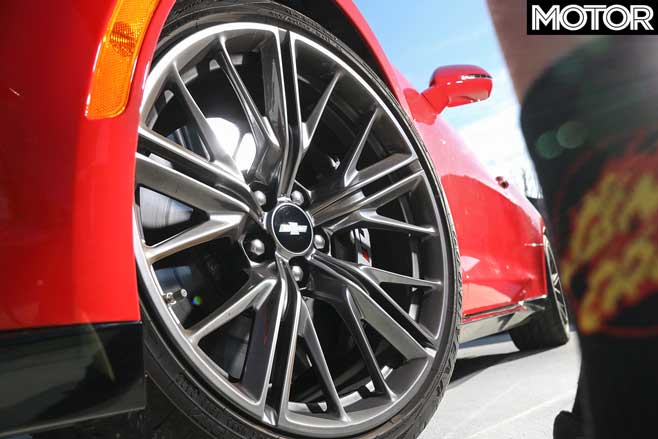
You may have noticed we’ve driven this car previously. In fact, its 13,600km odo suggests that plenty of people have. Check out MOTOR August 2019, when it met the Mercedes-AMG C63 S Coupe and Ford Mustang Shelby Super Snake widebody. Sister magazine Street Machine even took it to the most recent Drag Challenge. Luckily, they didn’t chew through the set of Mickey Thompson drag radials they took along, so we’ll fit them to the ZL1 when we go to the strip.
But this is more than just some one-dimensional muscle cruiser hell-bent on quarter-mile times, as a ZL1 with an optional 1LE pack (only available in America) tore around the Nürburgring Nordschleife in 7min 16sec back in 2017. That’s faster than the Porsche 997.2 911 GT2 RS.
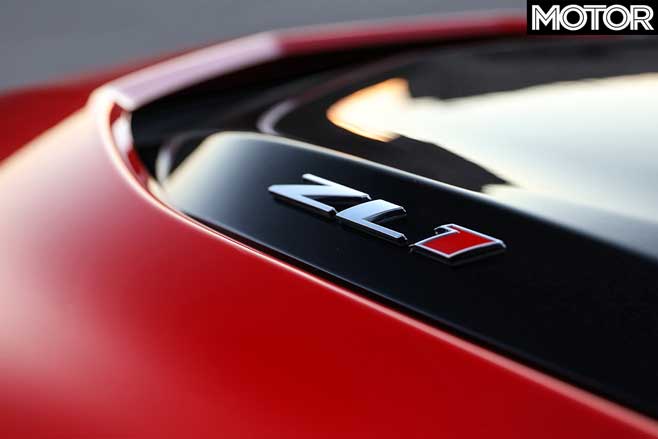
It has adaptive dampers, something unavailable and much needed on the $86,990 Camaro 2SS, while up front are massive six-piston Brembo brakes. Adjustable electric Recaro seats also feature. We don’t get the fearsome 1LE pack in Australia, but HSV does offer Goodyear Supercar Eagle 3 tyres as an option for $1000. They’re the tyres it’s meant to use but according to HSV they didn’t pass the ADR split-surface test, so it comes with Continental ContiSportContact Sport 5s instead.
You can bet I’ll see if the Continentals can handle its prodigious grunt. Maybe even sneak in a track session to try them back-to-back with the Goodyears. But our short time together so far suggests they’ll struggle. Do as much as breathe on the throttle and you’ll trigger the ESC.
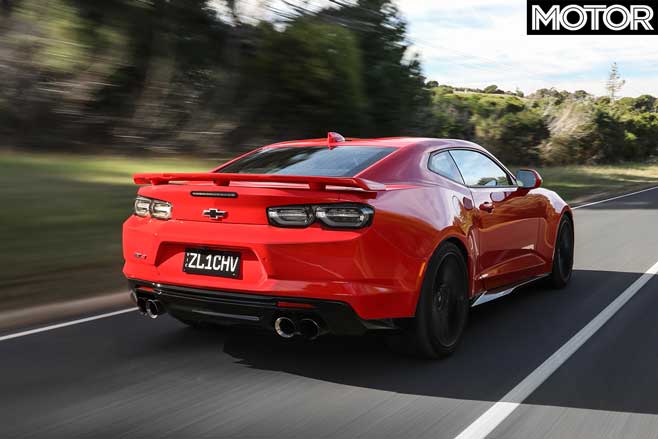
Other impressions so far? It’s a fairly stressful thing to potter around town. The car is 4831mm long, so half a ruler short of five metres, while WW2 machine-gun bunkers would boast better visibility. You sit low in what is an already low-riding car with a high beltline. I quickly gave up on darting traffic manoeuvres.
The doors are long, so it’s fairly difficult to get out of, and it could use some front parking sensors.
Then there’s its thirst. Its first fill came in at 17.1 litres per 100km and it hadn’t even come close to a track.
Or full throttle.
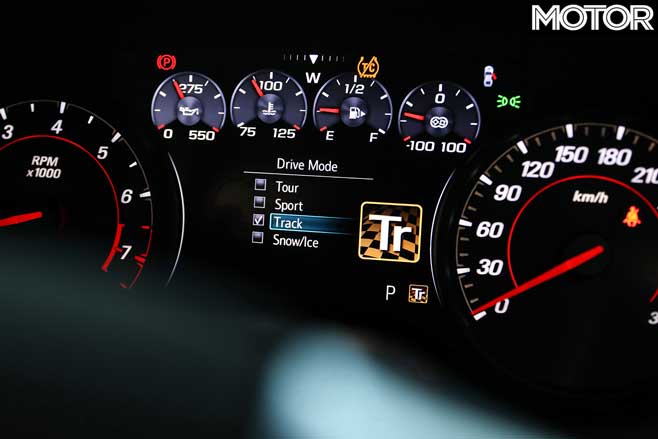
Yet you don’t need anywhere near that to sense the monster lurking just beneath the surface. That LT4’s strong bottom-end means it lazily closes gaps in traffic, and the supercharger whine chimes in to remind you of how many horses it can unleash on demand.
But it’s a smooth cruiser. And I’m impressed with how solid the interior looks and feels after all the hard, press-driven kilometres it’s endured. There’s not a squeak or rattle from the dash.
Ultimately, we’re hoping to discover whether this $163,100 muscle coupe is everything that price implies it’s cracked up to be.
No matter what the result, though, at the end of six months we know that this journey is at least going to be entertaining.
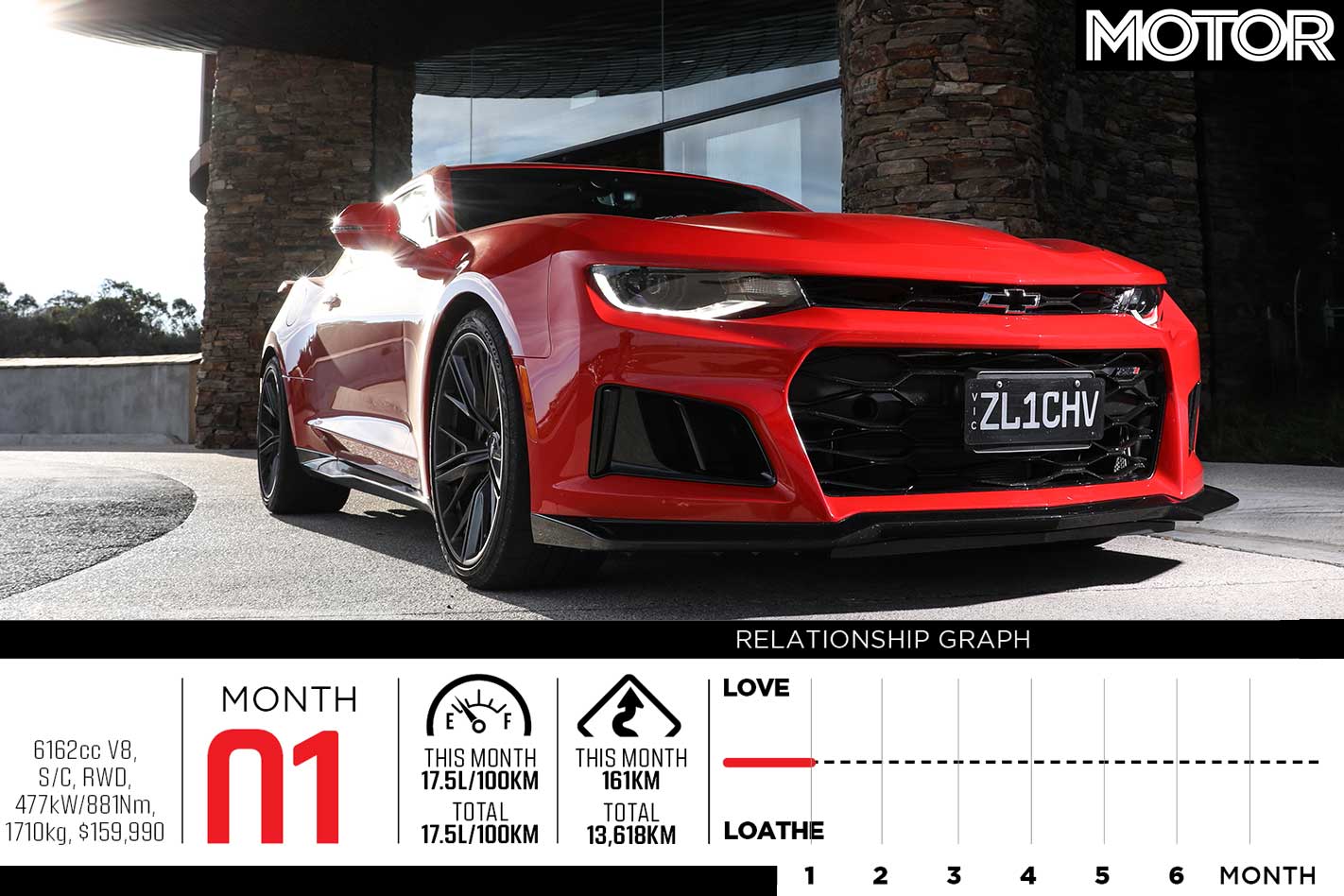
2019 Chevrolet Camaro ZL1 Pros & Cons
Things we love 1 – Seats 2 – Looks 3 – Blower whine
Things we loathe 1 – Visibility 2 – Thirst 3 – Size
*This article originally stated the LT4 V8 in the ZL1 used a 1.4-litre supercharger. That was incorrect, it uses a 1.7-litre unit.
Update 1: Fear Factor
Trying to turn 477kW and 881Nm into 10sec runs on a dusty strip
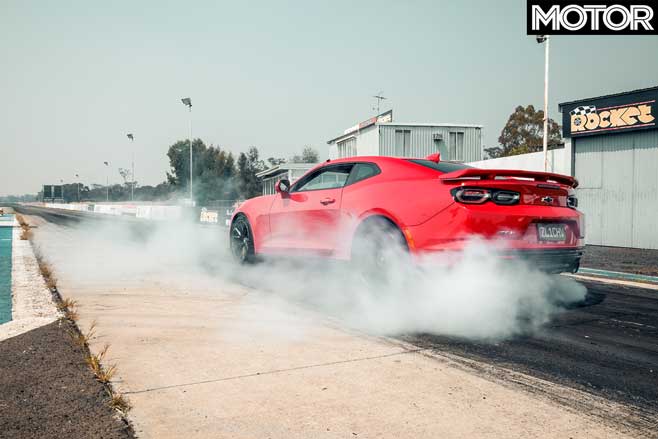
When word got out I had booked Heathcote Raceway for my next Camaro ZL1 update, Associate Editor Newman didn’t mince words: “Get into the 10s… or don’t come back at all.”
He was joking of course. But I understood. He’d achieved some respectable times at PCOTY, like a 3.9sec run to 100km/h from rest and a 11.7sec 400m pass, but they were still about half a second adrift from Chevrolet’s own figures. Now it was up to me to show everyone what the Chevrolet Camaro ZL1 can really do.
While the Yanks tend to apply one-foot roll-out for the lowest possible time, that would still leave a tenth or two on the table. Fortunately for us, sister mag Street Machine didn’t quite finish off a set of Mickey Thompson street drag radials at Drag Challenge, making them fair game. Newman’s challenge was on.
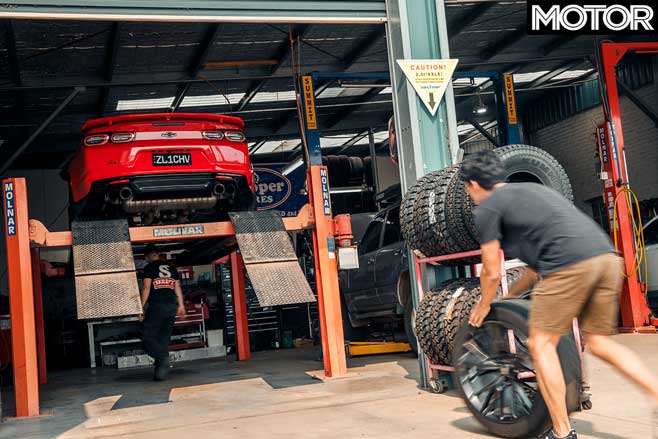
Why shoot for 10s though? While some supercars are good for 9sec runs these days, it’s still the benchmark achievement for a street car. And the Street Machine crew extracted an 11.2sec quarter-mile from the ZL1 at Calder Park Raceway (with roll-out applied) at 204km/h, so it felt like our duty to finish the job.
Then there’s the hardware bolted to the ZL1, implying such things are possible. Like the blown 6.2-litre V8, which will light up with 477kW at 6400rpm and 881Nm at 3600rpm. It’s hooked up to a special 10-speed auto and an electronically controlled rear locking diff. And a suite of electronic aids boast a tyre-frying line-lock feature, customisable launch control and a specialised ESC mode to help the ZL1 handle its massive grunt.
How I saw it panning out in my mind was rocking up to Heathcote, fitting the Mickey Thompsons, ripping a burnout, logging a 10.9sec run and then calling it a day. That goes to show how naive I was, because it panned out completely differently.
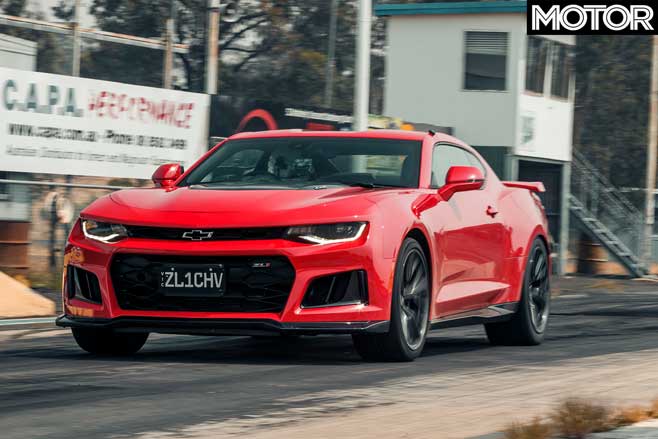
Let’s start with the tyres. Since the ZL1’s equipped with a can of tyre goo, HSV says there’s no need for regular jacking points. So to avoid any dramas I relied on Heathcote’s local tyre shop to help swap the rear wheels.
This pushed our start time from mid-morning into the middle of a Victorian summer day when the mercury crept into the mid-30s.
Once we arrived, though, it was clear temperatures were not going to be the biggest issue. Dry winds had coated the place in fine brown dust. Like the cocoa on a mousse cake.
I still had hope. The ZL1’s state-of-the-art launch control and line-lock feature would at least get the tyres sticky since it locks the front brakes, opens the rears, then lets you go nuts on the throttle for 15 seconds.
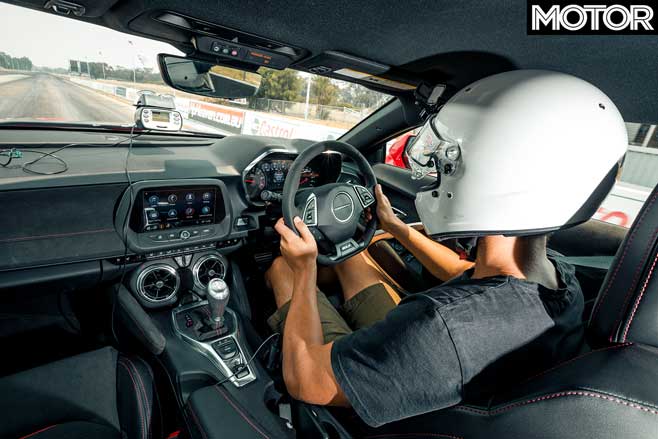
I switched off traction control, quickly tapped the ESC button twice to activate Stabilitrak mode (equivalent to HSV’s Competition Mode) and then rummaged through the Options menu on the cluster to engage Line Lock. Did it work? Well, let’s just say you probably could have seen the smoke from space.
You also have the option to walk the car forward and lay hot rubber strips to trace on your next run by pressing the buttons on each steering wheel keypad. But it wouldn’t have mattered, because the dust made the strip diabolically slippery.
The constant rev flares accompanying our maiden 4.6sec 0-100km/h run warned us something wasn’t right. Even playing around with the ZL1’s customisable launch control, where you can pre-set the launch rpm and slip target, couldn’t prevent the rpms from sporadically jumping at the redline over the first 100 metres. There was no grip. I’ll admit it was scary.
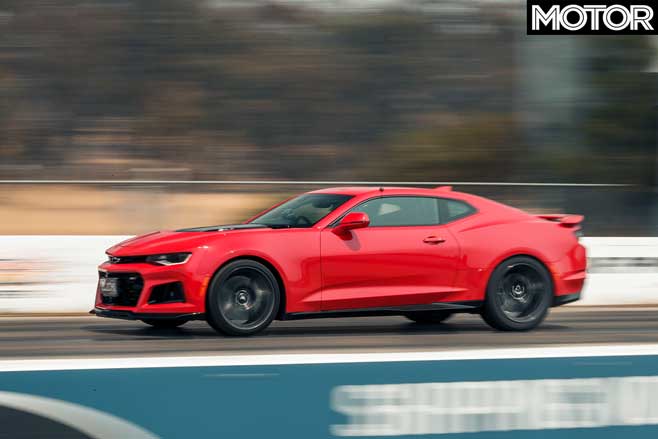
Meanwhile, trap speeds that varied between 191-197km/h with no link to quarter-mile times – for instance, a 12.2sec pass came with 191.4km/h, whereas a 12.6sec carried 195.6km/h – proved the ZL1’s normally relaxed ESC mode was working overtime over the whole distance. Forget about trying a run with it completely disabled.
In hindsight, the day was always going to be difficult. I later learned Mickey Thompson recommends keeping the tyres relatively cool on hot surfaces. So, you know, not literally smoking hot as we thought. It also says inconsistent times mean the tyres are on their way out, which might partly explain our results.
Next time, we’ll bring a tyre temp gauge, start at sparrow’s fart and, most importantly, wait for a clean, dry strip. But that’s racing. You learn from your mistakes. Maybe we’ll get another chance when we test a manual ZL1 in an upcoming update. Let’s just hope by then Newman has allowed me back in the office.
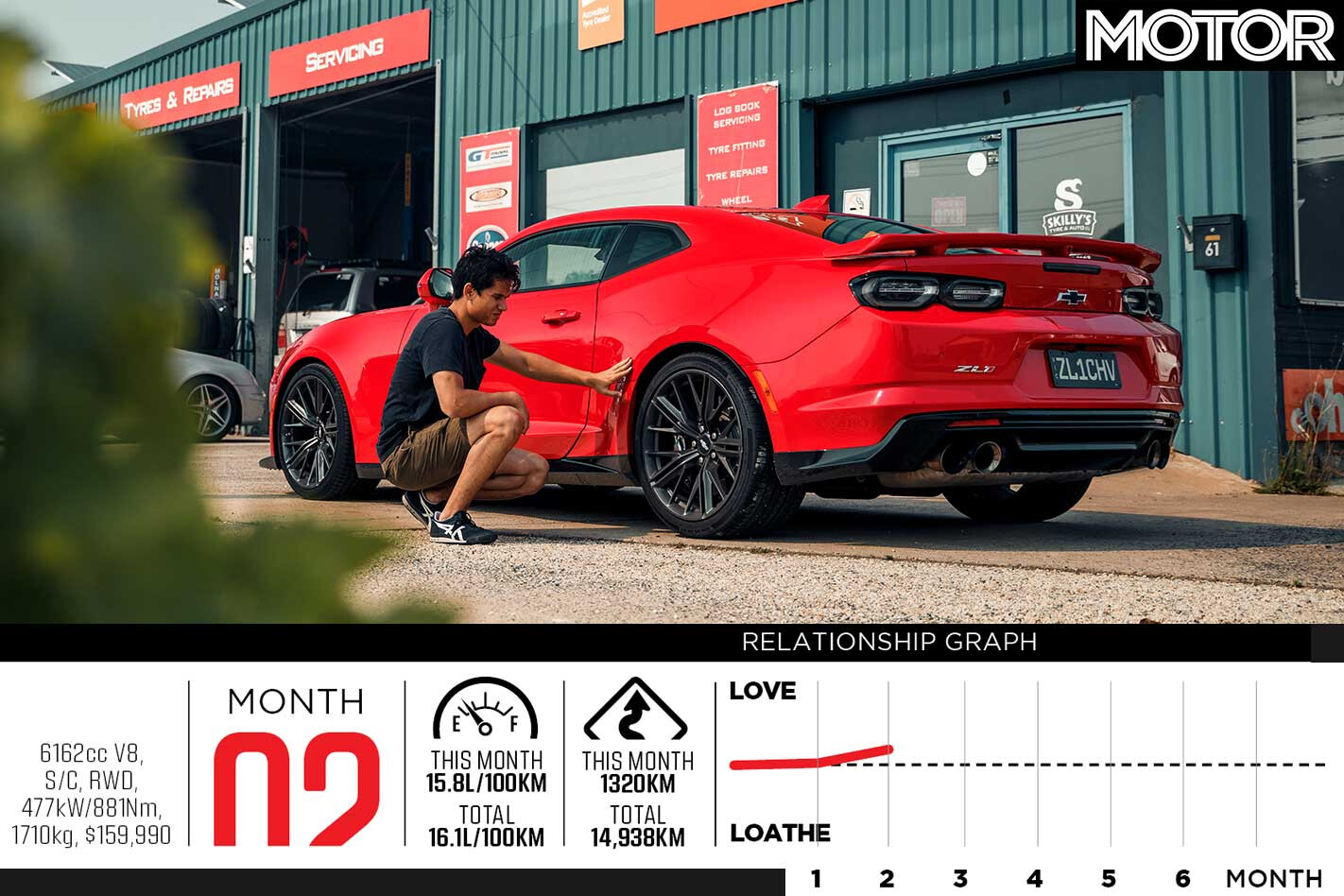
2019 Chevrolet Camaro ZL1 Pros & Cons
Things we’re falling for 1 – Line Lock 2 – Reliability 3 – Presence
Things we’re not fond of 1 – Two-wheel drive? 2 – Tricky jack points 3 – Not much else
Update 3: Power Hungry
How the big, bad ZL1 measures up on the dyno
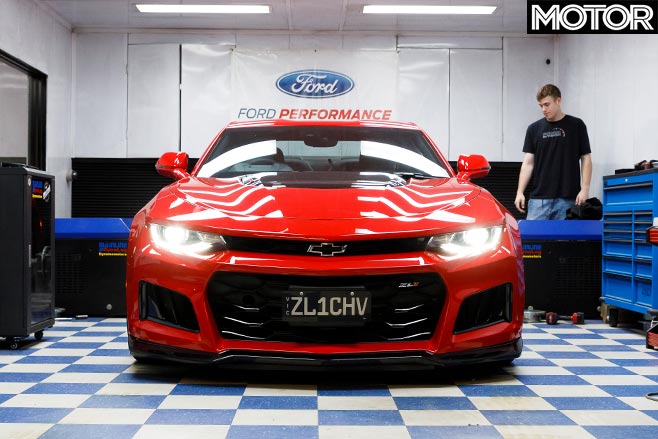
It’s only been a couple months since we discovered our previous long-term Peugeot 308 GTi wasn’t the hot hatch lightweight it claimed to be.
After seeing for ourselves the Frenchie was carrying an extra 100kg around its belly than claimed, it left me somewhat cynical about manufacturer data. Especially when it’s impressive.
So this morning I’m parked outside Herrod Performance in Melbourne’s northern suburbs. After Peugeot-gate, I wanted the truth on the ZL1, and figured we would find it on the dyno. Besides, some have speculated that HSV outputs never feel as strong in the real world as they might suggest. And then there’s the fact Chevrolet claims the sixth-gen Camaro is significantly lighter than the fifth-gen – which its spec sheet confirms. But what’s the real story on these numbers?
Herrod Performance’s hub dyno will start us off nicely. As described, it measures power at the rear hubs rather than the engine flywheel, so it’s inevitable the drivetrain will absorb some of the grunt that would otherwise count towards its outputs.
That said, the widely accepted drivetrain loss for a factory rear-drive car on a rolling dyno is around 20 per cent. And, given the hub dyno eliminates the inconsistencies a tyre introduces, the ZL1’s outputs should be closer to its claimed figures.
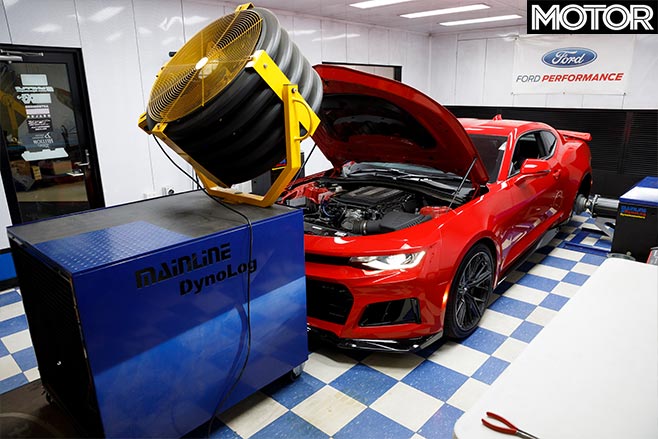
Speaking of which, local testing puts the ZL1’s LT4 blown V8 at 477kW and 881Nm. That’s 8kW less than the US-model ZL1, but that could be due to HSV’s European-based test (ECE-85,
if you’re curious) differing from Chevrolet’s SAE J1349 rules – which, from what we researched, mainly comes down to available fuels and fitted engine accessories.
After removing the wheels, attaching hub packs and switching on fans, dyno operator Chris Herrod jumps in the ZL1 and runs the 10-speed auto through its gears to bring the engine to ‘boil’. He then shifts into seventh, which has a 1:1 gear ratio, and lets her rip.
The roar shared between the engine, dyno and cooling fans builds as Chris revs out the ZL1. He then goes again for good measure. Once it’s done and the place falls quiet, a mechanic from the workshop pops his head in. They’ve placed bets on the result.
“Four-eighteen on the first run,” I announce. They were all wrong, landing either side of that number.
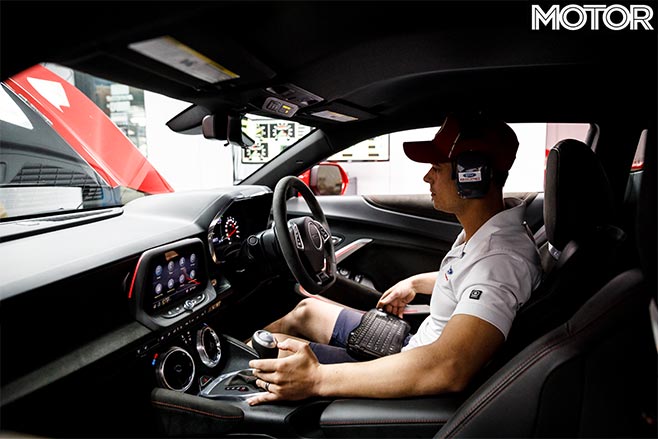
Chris wants another run once the ZL1 has had time to cool, just to be sure. But, while it’s more consistent on this next run, the ZL1 is no more powerful. It logs 417kW/777Nm and then 415kW/760Nm, which even Chris admits is good. I figure that’s about right, since 417kW (at 5905rpm) and 777Nm (at 3726rpm) is only 60kW and 105Nm shy of its 477kW and 881Nm claim, equalling about 12.6 and 11.8 per cent less respectively.
This means that, after the engine squeezes its power through the 10-speed ’box, down a prop shaft, into a rear electronically controlled LSD and outwards via half shafts, almost 90 per cent of its grunt still finds its way to the rear wheels on a warm day.
That’s impressive, but it won’t feel like it if the ZL1 is actually lugging around more flab than we thought. HSV quotes an official unladen mass of 1807kg for an automatic ZL1. And the BP service centre in Scoresby, just off the Eastlink freeway in eastern Melbourne, has scales to verify that.
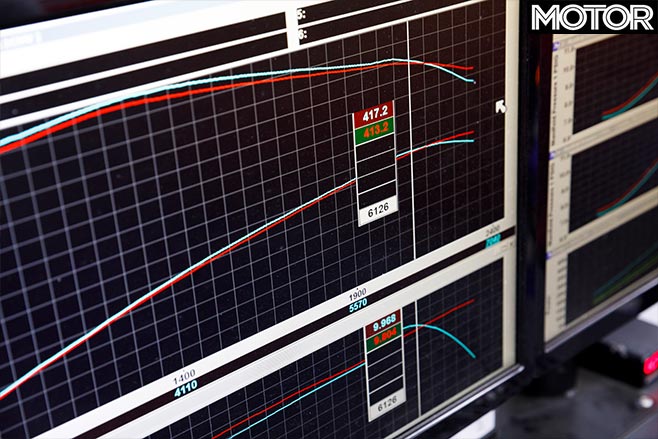
After leaving Herrod Performance I head there, brim the ZL1’s 72-litre tank and enter the weighbridge. The printout says 1.88 tonnes, suggesting the exact number lies somewhere between 1875 and 1884kg as I stand on the scales. Subtracting my weight (82kg) means the ZL1, while ‘wet’, actually weighs between 1793kg and 1802kg – or 5kg better than claimed.
This vindicates the work GM put into shedding weight from the new Camaro’s chassis, especially given the previous generation ZL1 weighed in at 1882kg. And I guess that might be why I smashed its claimed fuel consumption this month.
It wasn’t the most scientific attempt, but it did involve driving to Victoria’s Surf Coast while restraining from wide-open throttle, a hard task in a 477kW beast that’s so inviting when it’s most savage. In the end it sipped as little as 12.2 litres per 100km, proving its 10 speeds and almost imperceptible cylinder shutdown tech actually means you can beat the claimed 15.3L/100km if you’re committed enough.
It’s ironic a CO2-spewing muscle car restored my faith in claims. But I should never have doubted it.
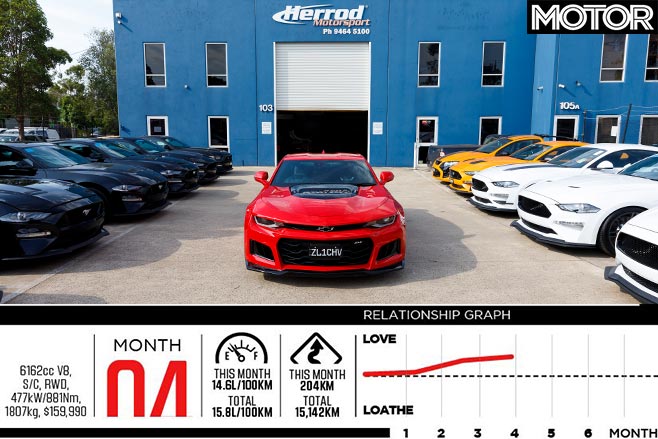
2019 Chevrolet Camaro ZL1 Pros & Cons
Things we’re falling for
1 – Potential frugality 2 – Truthful specs 3 – Relatively light
Things we’re not fond of
1 – Tyre noise 2 – Cramped cabin 3 – Not much else
Update 4: Brothers in Arms
Manual ZL1 or auto? Comparing them in a pre-COVID blast
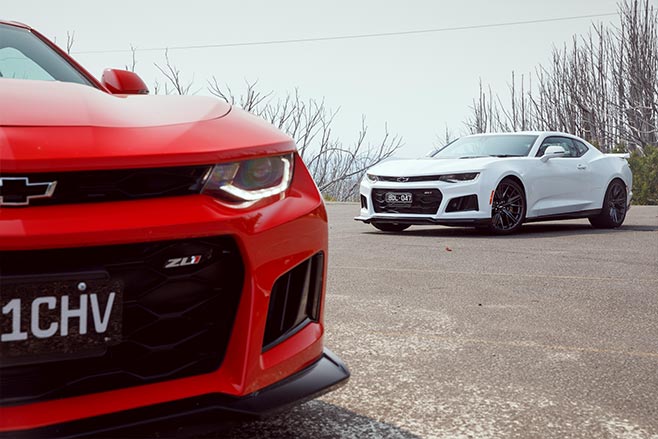
Let’s go back for a moment to when Corona was still known only as a beer. It was then that MOTOR needed to shoot a manual-equipped ZL1 for a run-of-the-mill road test.
With assigned tester Scott Newman unable to tag along, it was up to me who would bring the ‘camera car’ – my automatic ZL1 – which would enable me to refresh my memory on how it handles and sneak in a mini-comparison to answer a question in my head.
Does the ZL1’s monstrous LT4 obey Chevrolet’s 10-speed auto best? Or is it better mastered with the six-speed manual that eluded the range for a while until HSV added it to the build process? If the self-shifter’s anything like the unit in the 2SS, it’s going to be good. But it has to be.
A full (but individual) look at the manual ZL1!
GM is proud of its 10-speed automatic. It was launched with the ZL1 back in 2017, with the claim it was smoother, more efficient and faster than the eight-speed auto, and so far into this long-term journey we can attest it certainly feels that way.
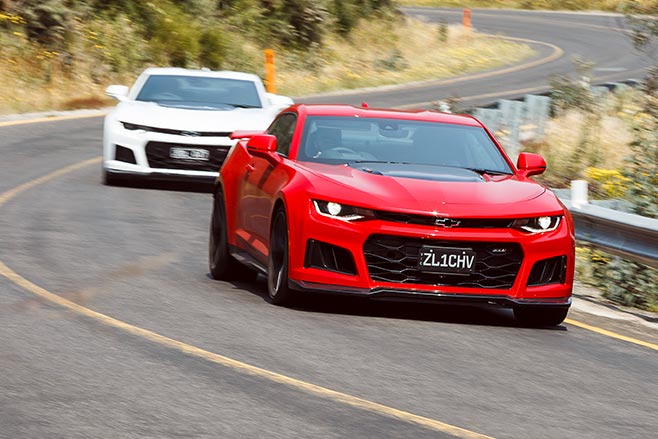
But out on Lake Mountain, our chosen photography location, we wanted to see if we could forge a closer connection to the ZL1 through a third pedal. We were lucky – the skies were clear, the weather warm and the eerie absence of any tourists welcoming; whatever traffic we did find, the sight of our 954kW/1762Nm convoy in their rear-view mirrors lit up indicator signals very quickly. Soon we breezed through the sleepy town of Marysville and got onto the Marysville-Woods Point Road, the beginning of this alpine blast.
I tackled it first in the manual. As Newman wrote last issue in the road test, it sports Tremec’s TR6060 MKJ transmission, and what struck me immediately were the loping gear ratios. Second stretches to a lofty 144km/h (!), so there was rarely a reason to shift, especially given the car’s torque-thick rev-range.
This in-gear feeling gave me some glimpse into what a single-gear Koeningsegg Regera might drive like, where you’re constantly surfing the engine’s mid-range to pull out of corners and then unfurling through the upper rpms to the rev limit on the really long stretches, but never feeling the need to grab another gear.
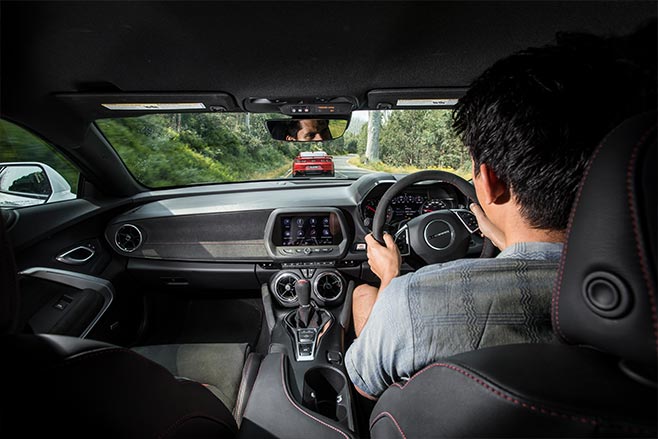
In ‘my’ auto ZL1, you’re usually a ratio higher, since second is geared to 100km/h and third 140km/h.
Given the auto’s smooth shifts, it rockets from bend to bend a fraction faster, getting up and into its higher revs more often. And the exhaust fires a pop on every shift with a visceral sound, offering a different aural experience to the manual, though they’re equally enjoyable. In the manual you’re left to revel in the LT4 V8’s hard-edged scream longer.
I also had no qualms with pedal placement, though the rev-match system, turned on and off by paddles behind the steering wheel, is there if you did. On feel, the clutch masks its strength with a light-but-firm action and forgiving bite point that’s only a problem if you’re trying to launch it.
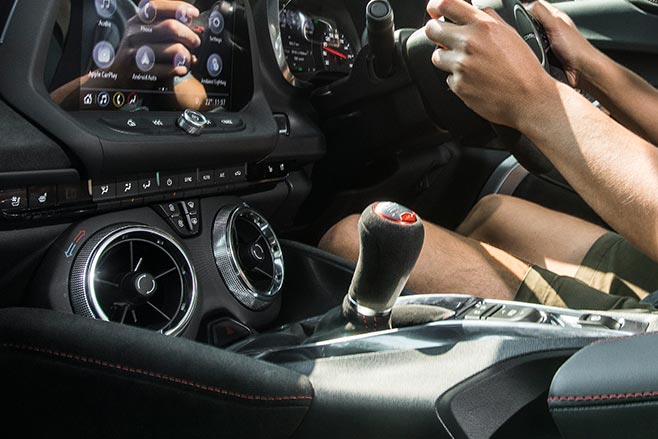
Meanwhile, the 10-speed auto is as quick and obedient. But it still lacks the crispness of a dual-clutch and tactility through its paddles. As a result, the manual’s slick and positive gate action is more involving and endearing.
The two cars handled Lake Mountain almost identically, with the manual still threatening to break into oversteer, even in third. Sometimes it seemed like I was braking too early and over-slowing the car, until a flare of revs when easing into the throttle confirmed I wasn’t. It demands respect.
Without the same innate chassis balance of something like, say, an M3, I had to settle each car’s mass early into a corner and then use weight transfer under throttle to maximise traction. It’s almost always wise to leave this monster’s ESC in Sport.
I have not fallen out of love with the auto, it was fantastic on this drive, but a part of me wishes I could swap it for the manual. I got a kick out of being able to wrangle 477kW/881Nm of muscle car through a small lever, like I was taming a lion with a stick. Its long gearing also better matches the engine’s ridiculous torque.
Yes, the manual would be more of a pain in traffic, but I’d be arranging my garage around the ZL1 as a Friday-to-Sunday car anyway – for reasons I’ll explain in my wrap-up next month.
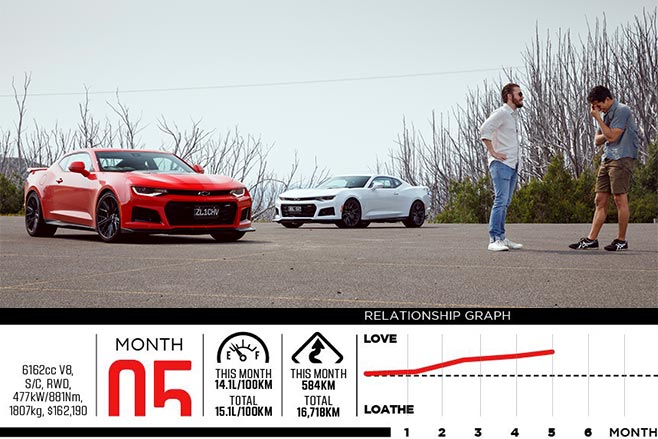
2019 Chevrolet Camaro ZL1 Pros & Cons
Things we’re falling for
1 – V8 scream 2 – Brakes 3 – Relative agility
Things we’re not fond of
1 – V8 scream 2 – Brakes 3 – Relative agility
Update 5: Farewell to the ZL1
It’s ten-four, good buddy, to our partner in crime
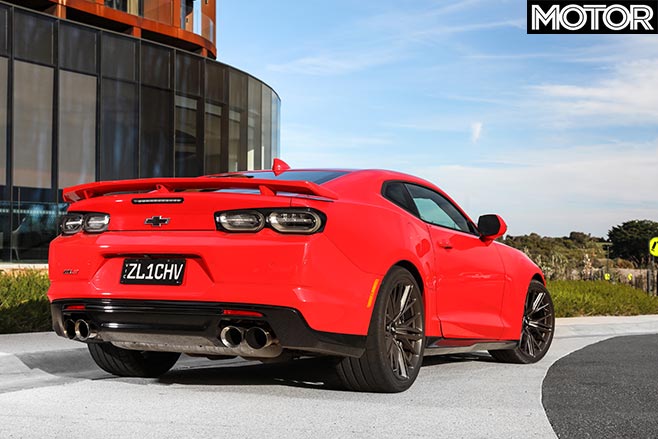
As far as long-termer goodbyes go, the Chevrolet Camaro ZL1’s farewell is more poignant than usual.
Holden announced earlier this year it was winding down for good, then a bloke in Wuhan ate a Pokemon and kneecapped the global economy, and to top it all off HSV also confirmed it would cease to exist. Local Camaro operations are kaput, leaving GM’s Aussie supply of big-power, rear-drive machinery wide open.
Luckily for us – possibly less so for HSV – supply for the ZL1 had been outstripping demand. Don’t tell anyone but you can pick up a dealer demo with around $30K lopped off the retail price, and lop off another $20K again if you’ll accept five figures on the odometer.
But whether it’s stealing a really low mileage demo for $130K or speccing your dream ZL1 with the new car smell for $162K, should you even consider Chevy’s monster 477kW supercharged boofhead at all?
Importing this thick slab of American muscle wasn’t easy for HSV, given the rebuild required to swap the steering wheel to the correct side and all the validation work that followed.
But save for a carried-over centre console (too expensive to change it they said, and so the cup holder is right where your elbow is when shifting a gear lever) the job is utterly seamless and possibly even better than the first time the interior was built. The only issue we had was some carpet that dislodged from the passenger side scuff plate.
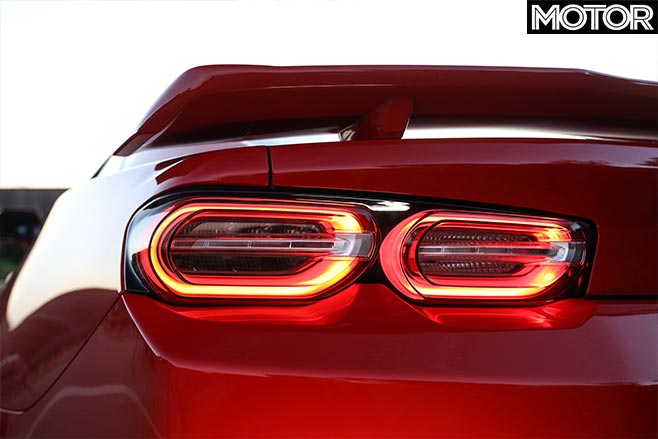
A bigger matter was just driving the thing around other cars, or town. While the FE4-spec Magneride suspension exclusive to ZL1s is a game changer for ride quality compared to the little bro SS’s passive setup, a bigger issue is, at 4.8 metres long and 1.9m wide, this low-slung coupe is not just a lane-filler but also quite tricky to see out of.
Get out on the open road and you’ll soon feel a bit more comfortable despite sitting on basically a four-wheeled tomahawk missile.
As said last month, the ZL1 compromises the daily drive to some degree to maximise its weekend-ability. Yes, there’s no doubt this car’s 6.2-litre LT4 V8 – packing enough power to corrupt a small democracy – is the star of the show, unrelenting, linear and giving a feeling of being bullet-proof.
There’s just no substitute for the ZL1’s blown V8 muscle car formula. Yes, there’s the $100K Ford Mustang R-Spec, but as we discovered, it can’t match the ZL1 for repeatability, winding the power back in hot weather to protect itself where the ZL1, very impressively, and with its glut of powertrain coolers, does not.
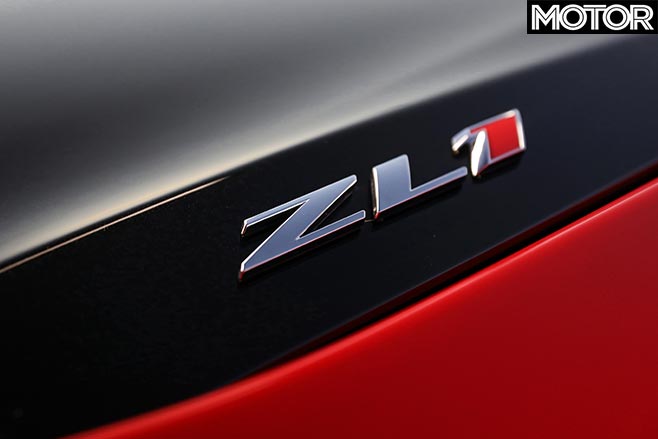
And how’s this for over-engineering? Even after 15,142 of rigorous journalistic testing kilometres on your behalf (ahem) including numerous circuit and drag strip spankings, the powertrain proved its health after winding a hub dyno up to 417kW and 777Nm.
And grab the US-standard Goodyear Eagle F1 Supercar 3 tyres if you can (HSV fits Continental ContiSportContact 5Ps to Aussie cars), because they translate all that mumbo into a 3.93sec 0-100km/h run and 11.73sec 400m sprint at 201km/h.
But if you’re throwing cheapies on the rear and just want to do something Tracy Grimshaw would disapprove of, the ZL1 will oblige, in a big way, thanks to the line-lock burnout function, left active in Aussie cars.
And when you’re done at Summernats and possibly heading back to the protect-you-from-you state, the ZL1’s chassis is good enough to tempt a stop at Winton and even a run over the mountains to swing back via Bairnsdale. Really.
Or just go the freeway and the ZL1 will run long distances and sip as little as 12.2 litres per 100km with ease, as its 10-speed auto hits snooze on the beast for 1400rpm at 100km/h. The auto, too, is smooth, responsive when it needs to be and even violently braps on full-noise upshifts, but it’s the manual’s long gearing that puts the focus back on the ZL1’s fearsome torque. And as such, the sweet-shifting, three-pedal six-speed is worth a look. The car in silver or black if you’re giving it to me.
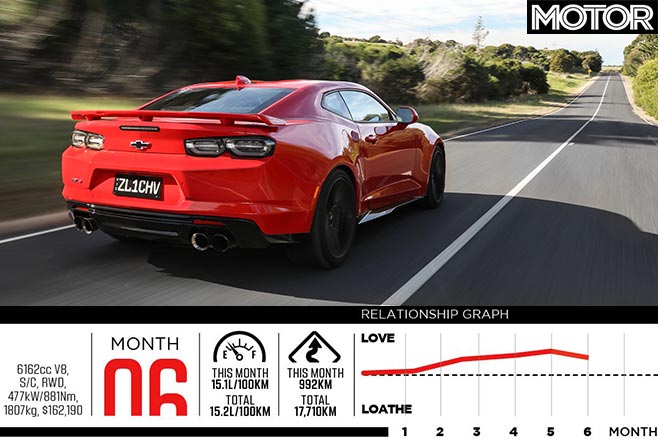
2019 Chevrolet Camaro ZL1 Pros & Cons
Yeah to:
- Didn’t break down
- Looks horn
- Abundant grunt
- Longer trips
- Thirsty gal
- Outward vision


